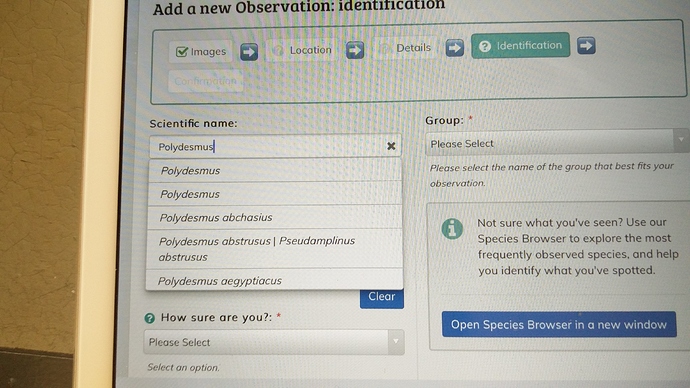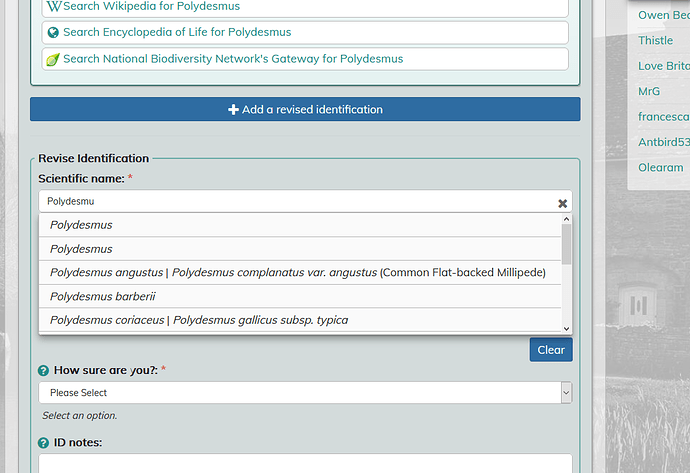See https://www.ispotnature.org/communities/uk-and-ireland/view/observation/799891/brown-leggy-thing-under-soil#new
How can I add a genus-level identification that iSpot won’t classify as a fungus (there is a “Polydesmus” in that Kingdom, too)? There are two “Polydesmus” options in the drop-down, but with no indication of which - if either - is the millipede/
I did Add Observation, went to Identification and entered Polydesmus.
.
I noticed when I clicked on one of the Polydesmus options that Fungi came up on the Group list. I clicked on the group box and was offered Invertebrates.
I didn’t do a whole test observation, but you could try it.
.
That’s what happened on the desk top. On the iPad the Group box said Select, which dropped down all the usual iSpot options of which Inverts was one.
I had though that this was a case of pick and hope, but you’re right - you can test an entry from the drop down list and see what comes up in the groups field. If your first pick was the fungus I don’t think editing the groups field would work. But you can go back to the identification field, reenter the name, and pick the other entry from the drop down box. I’ve tested it out, and it works.
I’ll try that on the PC, can’t work out how to bring up the “group” box on an Android phone. Thanks.
.
Updated: I couldn’t work out how to access the “group” box after selecting the second “Polydesmus” offering in the drop-down box. All I could edit was the confidence level and the comments (both PC and Android versions). How/where does one find the “groups” option, or see which group will be assigned?
Luckily, the second “Polydesmus” option was the invertebrate.
Lavateraguy’s reply is helpful. The Group box is to the right of the science name on my devices.
If we can post a photo here I could show you… can we do that in forum?
You can post a screenshot, and - as newcomers who put observations in the forum prove - photos too.
I read the above AFTER I had commented in the Observation
This has occurred several times in recent history - there are a few ‘duplicated’ Genera. Which ought to look like this
Polydesmus | Invertebrate
Polydesmus | Fungi
Polydesmus gallicus subsp. typica
Polydesmus gallicus subsp. gallicus
Etc…
We are supposed to add the tag taxonomy1 or absent1 when it occurs but no-one remembers to do that. Further, when the glorious time for the Taxonomy Update comes, admin will forget to look at the Tag-collection (which is far from definitive anyway).
Oh well…
thanks Amadan - I have just read the rubric which appears above as I type this reply. There are 13 icons to choose from as well as the helpful comment “Drag or paste images”.
.
And it worked. So I’ve learned something new (reading the rubric is a good idea).
.
This photo, from my ipad, shows the screen where I typed Polydesmus in the Scientific name box and, to the right, the Group box with the invitation to Select. I clicked on it to get the menu and then clicked on Invertebrates. I presume that will pick the right one for the post.
Then I thought of another cunning plan. I entered the name of a millipede in the Scientific name box (I chose one from Wikipedia) Apheloria. Entered that; iSpot dictionary automatically put Invertebrates in the Group box. Then I changed the scientific name to Polydesmus. The Group remained as Invertebrate, so maybe that will work for dual generic names.
Interesting.
If I add a dummy observation of my own, then I do indeed see a “group” option as shown in your screen-shot. But if I try adding a revision to an existing observation by someone else:
Then no such option appears.
I wonder what I am doing wrong?
iSpot generates the group from the identification. The ability to specify the group manually in Add Observation is to cater for the case where the observer doesn’t make an identification. Therefore it doesn’t apply when making a subsequent identification.
If you are making an observation, and are faced with this situation, if you pick an option, iSpot fills in the group for you. If the wrong group is filled in, go back and pick the other option, and iSpot again fills in the group for you, hopefully this time with the right one. I don’t know what happens if you edit the group field manually after specifying an identification - one could imagine the system going back to the name and looking for the right option (but what happens if you select mammal rather than invertebrate or fungus?), but judging by the various other problems around iSpot I doubt that this happens.
If you are adding an identification to an already existing observation, you can go and start adding an observation, and follow the above procedure, to find out when entry from the drop down list is wanted. Of course, it would all but much simpler if iSpot just disambiguated names in the drop down lists.
But I don’t get to see the “group” at all: that’s the problem. All I can edit (and see, as the screenshot shows) is the name fields, confidence, and ID Notes.
If you’re trying to add an identification to an already completed observation all you can do, other than pick and hope, is start up a new observation to test out the mapping of list entry to group. (See 3rd paragraph in previous reply.)
I ran headlong into Ctenophora today
see https://www.ispotnature.org/communities/global/view/observation/27145/sea-creature
It is true, the ONLY way to be certain, is to do a temporary test post. It does not require a photo but does require confidence and location. It takes only a few seconds to find out which is correct. I suppose we need to be alert to the presence of two Identical entries in the Drop-down, leave the Ob incomplete and do a test in New/Observation, then return to complete it.
If you abandon the test observation before the confirmation stage you don’t need to specify a location. Just jump straight to the identification tab.
Thanks for the help, chaps!
More than just a conflicting genus…
.
Looking for an French alpine butterfly…
https://commons.wikimedia.org/wiki/File:Alpine_butterfly_knot_diagram.png
Edited to add link
How nice. I relied on this knot and other ‘butterflies’ for years and often in VERY dangerous circumstances. I can still tie this one with my eyes closed yet cannot confirm this https://www.ispotnature.org/communities/global/view/observation/800643/
Much more than "…just a conflicting genus"
I had occasion to ID a fly today. It could also be a Virus
http://www.catalogueoflife.org/col/search/all/key/Drosophila+immigrans/fossil/0/match/1
A rare thing, two with the same Scientific names. (Different Families)
There are no Virii (IDs) in the iSpot Dictionary, so no issues to report.
You misread CoL. Drosophila immigrans is not the binomial of the virus. In this case the viral genus is Sigmavirus, and the species is denoted by giving the name of the host as a prefix, rather than an epithet as a suffix.
Virus nomenclature doesn’t use binomials. (Herpes simplex and Herpes zoster are diseases, not viruses.)
Ah yes, thanks. I did not follow up the Virus ID nor check any other source. I knew it would not be in the iSpot Dictionary.


